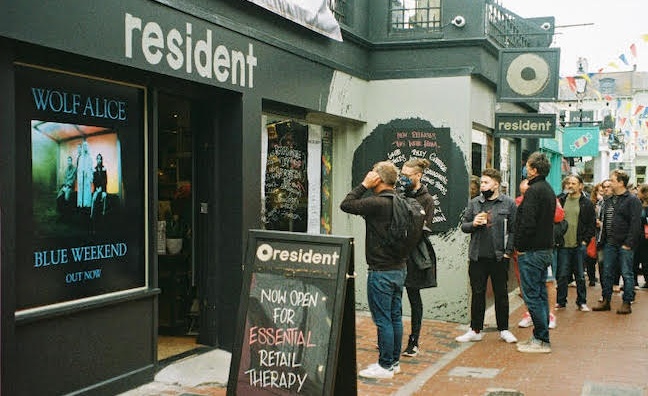The Entertainment Retailers Association has just released its 2022 Yearbook, which is essential reading for those who closely follow the UK music market’s performance.
While it was long associated with physical music, ERA now represents digital platforms, online suppliers and bricks-and-mortar retailers. So the trade body had a unique perspective during the DCMS Committee inquiry into streaming last year.
“An unfortunate by-product of the inquiry is that it has uncovered longstanding tensions on the supply side of the music industry, particularly between artists and songwriters and the larger music companies,” writes ERA CEO Kim Bayley in the latest edition of the Yearbook. “ERA takes no pleasure in this discord. We are also a part – an increasingly important part of music’s ecosystem - and we are committed to helping find a solution.”
Music Week has already reported on the headline numbers in ERA’s market study of 2021, including the first year-on-year increase in physical revenue in two decades.
Here, we dig deeper into five key talking points for recorded music consumption across physical and digital…
The price is right?
Music Week reported last month on the shrinking gap between sales revenues from vinyl (£135.6m in 2021) and CD (£150.1m). In 2019, the CD market was worth £217m compared to £97.1m for vinyl.
While CD still far outperforms the older format in terms of units (15.1m versus 5.6m last year), it’s predicted that vinyl will overtake CD on a revenue basis in 2022.
A major reason for that reversal is revealed in the latest ERA Yearbook: vinyl inflation. The average selling price of a vinyl LP in 2021 was £24.10, an increase of 11.4% year-on-year. In comparison, CD’s average price was £9.91, up 7.3%.
Music Week has reported on the price pressures resulting from supply issues. Adele’s 30, the biggest global vinyl release of 2021, retails for £30 compared to £11 for the CD. Prices of £40 for a double-vinyl release are now increasingly common.
Talking shop
Under difficult circumstances, indie retailers clearly had a good pandemic overall. Independent record shops increased their share of the vinyl market (units) to 30.3% in 2021, up from 24.9% just a year earlier. That result in 2020 was clearly a lockdown impact, as the indie sector was at 28% in 2019.
“Indie record stores, just as much as digital services, have been the big winners of the past decade,” said Kim Bayley. “ERA continues to support physical retail wherever we can, with two Record Store Day drops last year as well as our developing National Album Day promotion, now in its fifth year.”
As well as the boost from Record Store Day events in 2021, indies have benefited from supermarkets withdrawing from physical music. Once identified as a key part of the vinyl revival with an 8% share in 2017, supermarkets now account for just 1%.
Music specialists - which includes HMV and home delivery operators such as Amazon - saw their market share of vinyl drop by just over three percentage points last year, but they still command a strong lead with 68.7% of the market.
Ad it up
Streaming is still powering ahead, albeit at a slower rate of growth in a maturing market. For the record, audio streams were worth £1.3 billion in 2021, up 10.9% year-on-year. Streaming is now 80% of the market.
However, with the focus increasingly on premium subscription services, it’s worth remembering that ad-funded has not gone away (even if the music industry was never that keen on it).
While chart-eligible premium audio streaming units increased by 6.1% to 126.6 billion units in 2021, ad-funded streams were still up 3.5% to 20.6 billion. It’s a reminder that streaming growth is not based on a single consumer model, particularly if labels expect deeper market penetration in the years ahead.
Catalogue book
The ERA Yearbook is instructive when it comes to the catalogue boom. Of course, it’s powered by streaming but vinyl plays its part - Fleetwood’s Mac’s Rumours is a perennial favourite.
New release vinyl albums actually dipped in value slightly in 2020, but returned to growth last year with a 35.6% increase to £54.5m. Catalogue has been more steady on vinyl in recent years and it was up 16% to £81m.
It means that catalogue is now 59.8% of the vinyl market’s value compared to 40.2% for new releases (back to pre-pandemic levels).
ERA and the OCC also track units for catalogue and new releases, which show that the former has a 62.6% share compared to 37.4% for the latter. Value growth for all vinyl LPs of 23.2% compares with 10.6% unit growth (the effect of those price rises).
For CD, catalogue was more robust - a 2% year-on-year value dip - than new releases, which experienced a 5.4% decline.
Disc drive
ABBA’s Voyage was the biggest vinyl LP of 2021 with 40,104 sales, according to the Official Charts Company. Adele’s 30 was close behind (37,772) followed by Fleetwood Mac’s Rumours (34,592).
But another area of the vinyl revival is the singles market, where revenue increased 4.4% to £3.3m in 2021 (although units were down 5.5% to 0.3m). The biggest seller in 2021 was The Specials’ Ghost Town (5,385) followed by Harry Styles’ Watermelon Sugar (5,161) and Cosmic Dancer by Morrissey & David Bowie (3,774).
CD and other physical singles rocketed by 105.7% to 0.2m units in 2021, with 41% growth in revenue to £0.5m. ERA hasn’t produced a chart, although some of those will have been signed copies from Ed Sheeran, which has boosted his singles performance on recent releases.
Subscribers can read our 2021 market analysis here.









